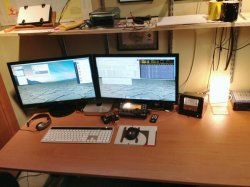You can put your entire home folder on the hard drive, however you still take a performance hit because applications write often to the Library folder.
It isn't as slow as having everything on legacy rotational hard drives, however it is slower than going all solid state.
However, there's an alternative (fairly) simple way to getting most of the solid state performance while having most of your stuff on the rotational drive for logistical simplicity.
Most applications are often writing to files in two specific Library subdirectories: caches and logs. If you can speed up read-write access to those, you've probably eliminated the majority of the disk bottlenecks.
Put your
- ~[login]/Library/Caches
- ~[login]/Library/Logs
somewhere on the solid state boot drive, and symlink to them. I generally put these files in the same logical place:
- /Volumes/[bootdrive]/Users/[login]/Library/Caches
- /Volumes/[bootdrive]/Users/[login]/Library/Logs
Note that this is very similar to the old Nineties database administration trick of putting logs, caches, control files, and rollback segments on separate hard drives (the old Oracle DBA guide by Loney covered this). This was known as the "22-disk dream database" as each rotational drive held
one file for the RDBMS. Spindle contention was reduced to an absolute minimum.
I only bother having Time Machine back up my hard drive (not my solid state boot drive which basically only has OS X and applications). In the case of a catastrophic boot drive failure, I would need to build a new one from scratch, but at least all of the user data is in a Time Machine backup.
The likelihood of a catastrophic boot drive failure is pretty rare, so I'm willing to hedge my bets and not bother backing up my boot drive, even if rebuilding it from scratch would take a day. I can live with those odds. Also, I really won't worry about recovering web browser caches or diagnostic logs. I'm not a bank or insurance company.
This method is really trailer park Fusion Drive, it's not for everyone. For folks like me who deliberately don't make Time Machine backups of boot drives, it works pretty well though.
Note: I am doing this on a Mac mini server (mid-2010) with a 128GB OCZ Vertex3 SSD boot drive, and the factory 500GB secondary HDD.
Anyhow, good luck.


